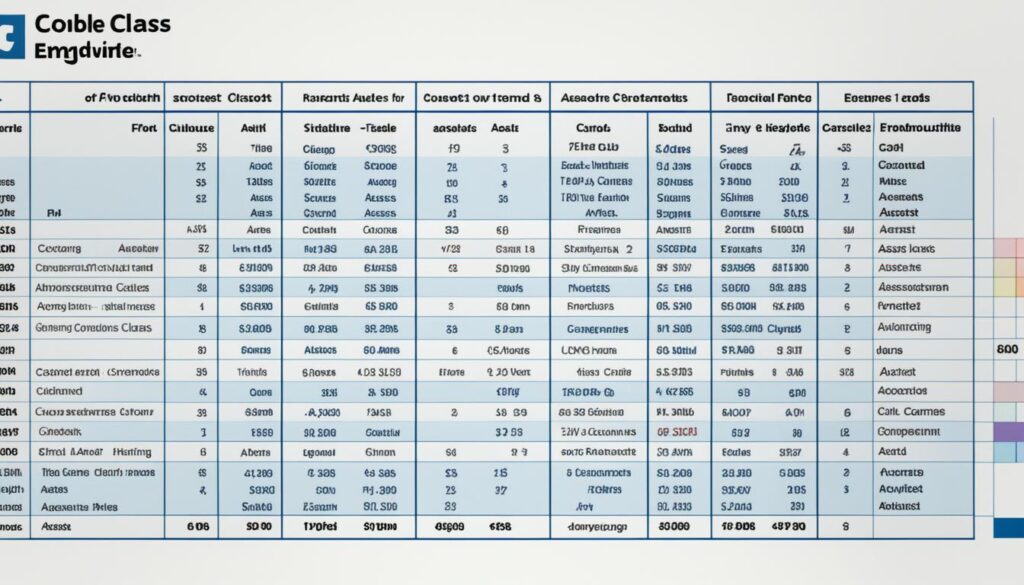Investing is key to financial independence and building your wealth for the long term. It’s useful whether saving for retirement or a home. But, starting out can feel overwhelming.
Don’t worry, though! This beginner’s guide will help you take your first steps. You will learn about setting goals and creating a diverse portfolio. This way, you can invest confidently.

Key Takeaways:
- Investing is crucial for achieving financial goals and building wealth over time.
- Setting clear investment goals is the first step in creating a successful investment plan.
- There are different investment vehicles to consider, such as brokerage accounts, retirement accounts, and robo-advisors.
- Determining the amount of money you want to invest and your risk tolerance is essential for creating an investment strategy.
- Building a well-diversified portfolio is key to managing risk and maximizing returns.
Decide Your Investment Goals
Before you dive into investing, you need to figure out what your goals are. Knowing what you want to achieve helps you pick the right investments. It also guides you in making a plan.
Having clear investment goals gives you direction. Think of them as a roadmap for your investing journey. They help you decide how to use your money wisely.
Think about what you want in the long run and the short run. Long-term goals might include saving for retirement or buying a house. These usually mean taking more risks because you have time.
If your goals are closer, like saving for a vacation or an emergency fund, you’ll focus on keeping your money safe. Short-term investing is about having access to your money when needed.
Start by listing out your goals. Figure out which are most important and consider how much risk you can handle. This helps you understand what you’re working towards.
“The starting point of all achievement is desire.” – Napoleon Hill
Once you know your goals, you’re ready to look into different investment options. The next part will help you choose the right ways to invest your money.
Select Your Investment Vehicles
After setting your investment goals, it’s time to pick the right investment tools that match your aims. There are many options for beginners, each with its benefits and things to think about:
1. Brokerage Account
A brokerage account lets you trade different investment products. This includes stocks, bonds, ETFs, and mutual funds. It helps you shape your portfolio to fit your risk willingness and investment choices.
With online brokerage platforms growing, getting a brokerage account is easier and more user-friendly than before.
2. Retirement Account
Retirement accounts, like IRAs or 401(k) plans, have special tax perks for saving for retirement. These accounts can offer tax deductions or tax-free growth. This lets your investments grow better.
Investing in a retirement account is wise for long-term planning. It’s especially true for those looking to protect their future financially.
3. Robo-Advisor
A robo-advisor is a digital platform that gives you personalized investment strategies. It bases these on your goals and risk level. This is great for beginners who want professional advice without the big fees of traditional financial advisors.
Robo-advisors often provide varied portfolios for different risk levels. This makes them a good option for those who prefer a hands-off approach.
“Choosing the right investment vehicle is crucial, as it sets the foundation for your investment journey. Consider your financial goals, risk tolerance, and level of involvement to make an informed decision.”
In choosing investment vehicles, think about:
- Flexibility: Can you easily access and manage your investments?
- Tax Advantages: Are there any tax benefits associated with the investment vehicle?
- Level of Customization: Does the investment vehicle allow you to tailor your portfolio to your specific needs?
Remember, the investment vehicles listed above are just some options, and more might fit your unique situation. It’s key to research and assess different investments before deciding. This ensures they meet your goals and risk comfort.

Calculate How Much Money You Want to Invest
Finding the right investment amount that fits your budget and goals is vital. It’s essential to figure out how much you can invest comfortably. If you’re starting with small amounts, don’t worry. Investing with small amounts can make a big difference over time due to compounding.
Take a good look at your income, expenses, and saving targets. Decide how much you can spare for investments without hurting your daily finances. It’s crucial to find a good balance between investing and keeping your finances healthy.
Investing is about the long run, and being consistent matters. Even with a small investment budget, regular investments can make a big difference over time.
Consider the following factors when determining your investment amount:
- Your income: Check your monthly cash flow to see what you can set aside comfortably.
- Your expenses: Keep an eye on your regular bills, debts, and other financial duties. Make sure you have enough left over to invest.
- Your savings goals: Think about your financial goals for the near and far future. Decide how much of your investment should go towards these goals.
Remember, every penny you invest counts. Starting with small amounts can help you reach your financial dreams. Stay disciplined, and your investment will grow over time.
Example:
| Financial Factors | Amount |
|---|---|
| Monthly Income | $5,000 |
| Monthly Expenses | $3,500 |
| Monthly Savings Goal | $500 |
| Investment Amount | $1,000 |

Measure Your Risk Tolerance
Knowing your risk tolerance is key when investing. It means looking at investment risks and deciding if they’re okay for you. Risk tolerance combines your emotion control during market changes and your ability to handle losses.
Figuring out your risk tolerance aligns your investment strategy with your needs and aims. It makes sure your investments fit you. This way, you avoid risks that could stress you out or shake your financial stability.
Assessing Your Risk Tolerance
Here are things to think about when evaluating your risk tolerance:
- Your financial goals: Identify your investment’s purpose and timeline. Are they for long-term needs like retirement, or short-term ones like buying a house?
- Your financial situation: Consider your income, expenses, and overall money health. How much of your money can face risk?
- Your investment knowledge: Look into how much you know about different investments and their risks. Do you feel confident in making market decisions?
- Your emotional resilience: Think about your reaction to market ups and downs. Does this volatility make you anxious or can you handle it?
Remember, risk is part of investing, and high returns usually come with high risks. It’s important to find a balance that matches your risk tolerance and financial goals.
Understanding Your Risk Capacity
Risk capacity is about your financial ability to endure losses. To figure out your risk capacity, consider:
- Your investment period: Longer investments often can handle more risk. They have time to recover from market drops.
- Your income stability: A steady income means you can probably take more risk. If your income varies, you might need to be more cautious.
- Your overall financial situation: Look at your debts, living costs, and emergency funds. These factors show how much risk you can safely take.
Knowing your risk tolerance and capacity lets you make smart investment choices. Risk varies from person to person, so assess your own situation. Always get advice when you need it.

| Risk Tolerance Level | Investment Strategy |
|---|---|
| Conservative | Emphasis on low-risk investments like bonds or cash. Aims at keeping your capital safe more than making it grow. |
| Moderate | Blends low and medium-risk investments. This strategy seeks moderate growth but keeps risk in check. |
| Aggressive | Focuses on high-risk options like stocks or real estate. Eyes higher returns but faces more ups and downs and losses. |
Consider What Kind of Investor You Want to Be
In the world of investing, everyone has their own approach. You choose your path based on your financial dreams, how much risk you can handle, and how long you plan to invest. It’s vital to know the different investor types and styles. This knowledge lets you make choices that fit your goals and preferences.
Short-Term Investing: Active and Engaged
Short-term investing means you’re all in. You actively manage your investments to make quick profits. This path requires you to keep a close eye on market trends and financial news. For those who love to dive into market ups and downs, this might be your game.
Success in short-term investing demands a deep understanding of the market. You must be ready to quickly analyze and act on changes. This style is best for those who have the time and knowledge for active trading.
Long-Term Investing: Passive and Patient
Prefer a laid-back approach? Then, long-term investing might be for you. This style is about growing your wealth slowly, over many years or decades. It depends on the magic of compounding, spreading your investments, and leveraging long-term market trends.
Long-term investing isn’t about quick wins. It’s about creating a diverse portfolio that meets your future financial needs. This method helps you stay calm during market lows and celebrates the growth over time.
Diversify Your Approach
Mixing short-term and long-term strategies can offer the best of both worlds. You can grab the chances that come in the short run while also building for the future. This blend adapts to both quick gains and steady growth.
Your investment style should match your financial aims and how much risk you’re okay with. Take time to think about what you want to achieve with your investments. Choosing the right path is key.

Understanding what kind of investor you want to be helps shape your strategy. This can lead you to success in the investing world.
Build Your Portfolio
Building a well-diversified investment portfolio is key for managing risk and boosting returns. A well-planned portfolio helps you handle market ups and downs. It also helps you reach your long-term investment dreams. Here are some tips to build it right:
Asset Allocation
Asset allocation is crucial for a good portfolio. It means spreading your investments across different areas like stocks, bonds, and real estate. This is based on what you want to achieve and how much risk you can handle. Diversifying this way helps lessen the effect of market changes on your portfolio.
Investment Diversification
Diversifying your investments within each asset class is important too. This spreads out risk. By investing in various securities, industries, and places, you reduce the risk of big losses from a single investment. Diversification is a smart way to protect your portfolio.
Regular Review and Rebalancing
Keeping your portfolio in line with your goals needs regular review and rebalancing. Checking your portfolio lets you adjust based on performance. Rebalancing means changing your investments to keep your desired asset mix. Doing this helps keep your risk level in check and grab market chances.
Remember, creating an investment portfolio is a continuous journey. It needs constant monitoring and updates. Stay up-to-date with market trends and maybe get professional advice when needed. A well-managed and diversified portfolio sets you up for success in the changing investment world.

Monitor and Rebalance Your Portfolio Over Time
After creating your investment portfolio, it’s key to watch how it does and adjust when needed. By doing this, you can get the most out of your investments and achieve your financial goals.
Stay Informed with Portfolio Monitoring
To watch your portfolio well, you must track market trends, economic updates, and investment changes. Use reliable financial news, market reports, and expert analysis. This helps you make smart investment choices and spot both opportunities and risks.
Also, use technology to help monitor your portfolio. These tools can give you instant updates on your investments and news that might affect them.
Rebalance Your Portfolio to Maintain Asset Allocation
Market changes can shift your portfolio away from your planned strategy. That’s when you need to rebalance. Rebalancing means adjusting your portfolio to follow your set investment mix again.
Check your portfolio’s mix regularly and rebalance if needed. Sell investments that are too large a part of your portfolio and buy more where you have too little. This keeps your portfolio in line with your risk level and goals.
Track Investment Performance and Track Progress
Tracking your investment performance helps you see if you’re meeting your goals. Always review your portfolio returns and compare them to benchmarks like market indexes.
Remember, it’s best to look at performance over the long term. Short-term ups and downs are normal. Stay focused on your long-term goals.

Other Key Things to Know About Investing as a Beginner
Starting out in investing requires learning a few basics. This includes understanding risk and return, diversification, and different types of investments. With these basics, you can make smarter choices and feel more confident.
Avoiding common errors is another important thing for new investors. Mistakes include chasing the latest trends, trying to outguess market timing, or making decisions based on emotions. Knowing these pitfalls helps you dodge losses and improve your investing methods.
Investment is a long journey, not a quick race. It’s important to be patient and keep your eyes on your long-term goals. Ignore short changes in the market. Slow and steady wins the race in building wealth through investments.
Self-education is vital, but sometimes you might need expert advice. A financial planner can offer advice tailored to your unique needs. They can be particularly helpful if you’re facing complex financial situations or have specific aims.
Beginner Investing Tips
- Starting small is wise when you’re new. Invest a manageable amount to learn without risking too much.
- Diversifying your investments is key. Spread them across different areas to lower risk and potentially increase growth.
- Keep yourself updated on financial news and market trends. Being informed helps you make better investment choices.
- Invest regularly, even small amounts. This takes advantage of compounding and boosts long-term returns.
Common Investing Mistakes
- Following the latest investment trends can be risky. Often, by the time a trend is popular, it’s too late for the big rewards.
- Timing the market is nearly impossible. Trying to do so can mean missing out and harming long-term success.
- Making emotional investment decisions can hurt returns. Keep a cool head and stick to your plan for the best outcomes.
Learning about investments is an ongoing journey. Stay eager to learn as you explore investing. The more you know, the more prepared you are to make wise decisions and increase your wealth over time.

Start Investing Today: Take Action Towards Growing Your Wealth
You now know the key steps for investing. It’s time to act. The first step is to open an investment account. There are many options to fit your needs and preferences.
Brokerage Account
Opening a brokerage account with a trusted financial institution is a good move. Such an account lets you trade many investments like stocks, bonds, and mutual funds. You get tools and options to shape your portfolio based on your goals.
Retirement Account
For retirement, consider an Individual Retirement Account (IRA) or a 401(k) if your job offers it. These accounts have tax benefits and a wide range of investment options.
Robo-Advisor Platform
A robo-advisor platform suits those new to investing or who prefer a hands-off approach. They use algorithms to build and manage a portfolio for you. Robo-advisors have lower fees than traditional advisors and offer an easy, automated investment experience.
After picking the right investment account, make an investment strategy that fits your goals and risk level. Consider starting with:
- Index Fund Investing: Put money in low-cost index funds that follow a market index, like the S&P 500. It’s good for long-term investing.
- Dollar-Cost Averaging: Invest a set amount regularly, no matter the market’s state. This method can help lessen the impact of market swings.
- Dividend Investing: Choose stocks or funds that give regular dividends. This can give you a steady income over time.
Remember, investing is for the long run. Start with an amount you’re comfy with. You can always invest more as you can. Taking action now puts you on the path to wealth and meeting your financial goals.

| Benefits of Taking Action on Investments: | Beginner Investment Strategies: |
|---|---|
|
|
|
|
|
|
|
|
|
|
|
Conclusion: Unlock Your Financial Potential through Investing
Investing is a key way to grow your wealth over time. This beginner’s guide has given you a good start. Now, you know how to move forward with confidence in investing.
To build wealth, staying focused on long-term goals is vital. You should keep up with market trends and economic news. Use resources like newsletters and educational content to learn more.
Investing is all about patience and keeping a long-term view. Don’t let short-term changes make you act on impulse. Stick to your plan but be ready to adjust when needed.
It’s time to begin your investing journey. With commitment and the right methods, you can grow your money. Start now and work towards a secure and wealthy future.